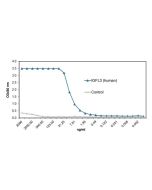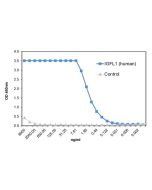Cookie Policy: This site uses cookies to improve your experience. You can find out more about our use of cookies in our Privacy Policy. By continuing to browse this site you agree to our use of cookies.
AdipoGen Life Sciences
Isthmin-1 (human) (rec.) (His)

| Product Details | |
|---|---|
| Synonyms | C20orf82; ISM1; ISM |
| Product Type | Protein |
| Properties | |
| Source/Host | HEK 293 cells |
| Sequence |
Human isthmin-1 (aa 30-464) is fused at the C-terminus to a His-tag. |
| Crossreactivity | Human |
| MW | ~65kDa (SDS-PAGE) |
| Purity | ≥95% (SDS-PAGE) |
| Endotoxin Content | <0.01EU/μg purified protein (LAL test). |
| Concentration | 1mg/ml after reconstitution. |
| Reconstitution | Reconstitute with 50µl endotoxin-free water. |
| Accession Number | B1AKI9 |
| Formulation | Lyophilized. Contains PBS. |
| Other Product Data |
UniProt link B1AKI9: Isthmin-1 (human) Protein |
| Shipping and Handling | |
| Shipping | BLUE ICE |
| Short Term Storage | +4°C |
| Long Term Storage | -20°C |
| Handling Advice |
After opening, prepare aliquots and store at -20°C. Avoid freeze/thaw cycles. Centrifuge lyophilized vial before opening and reconstitution. For maximum product recovery after thawing, centrifuge the vial before opening the cap. |
| Use/Stability |
Stable for at least 6 months after receipt when stored at -20°C. Working aliquots are stable for up to 3 months when stored at -20°C. |
| Documents | |
| MSDS |
 Download PDF Download PDF |
| Product Specification Sheet | |
| Datasheet |
 Download PDF Download PDF |
Isthmin-1 (ISM1) was first identified as a gene expressed in the Xenopus midbrain hind brain organizer called isthmus, with a proposed role during early brain development. Isthmin-1 encodes a predicted ~50-kDa protein containing a signal peptide, a thrombospondin domain and an adhesion-associated domain. Isthmin-1 is important for embryonic and postnatal development. Growing evidence has shown that aberrant expression of Isthmin-1 can also affect the biological behavior of cancer. The Ism1 gene is conserved in mice and humans.
A recent study showed that Ism1 is an adipokine that induces glucose uptake in human and mouse adipocytes. Ism1 is secreted by mature adipocytes and triggers a signaling cascade similar to that of insulin, regulating glucose uptake while suppressing lipid accumulation.
Recombinant Isthmin-1 or overexpression of Ism1 causes a robust increase in GLUT4-dependent glucose uptake in cultured primary murine and immortalized human adipocytes as well as in primary human muscle cells and prevents insulin resistance and hepatic steatosis in a diet-induced obesity mouse model. Ablation of Isthmin-1 causes glucose intolerance and impaired insulin-stimulated adipocyte glucose uptake. Isthmin-1 suppresses de novo lipogenesis and increases protein synthesis in hepatocytes whereas Isthmin-1 knockdown in adipocytes reduces glucose uptake and insulin-dependent phosphorylation of protein kinase AKT at serine residue 473 (p-AKTSer473). Isthmin-1 signaling is dependent on PI3K and shares downstream phosphorylation targets with insulin signaling, such as p-AKTSer473, p-AKTThr308, p-ERK1/2Thr202/Tyr204 and p-S6Ser235/236. Isthmin-1 does not seem to act through the insulin receptor or the insulin-like growth factor 1 receptor; it is most likely to signal through another, yet to be identified, receptor tyrosine kinase.








